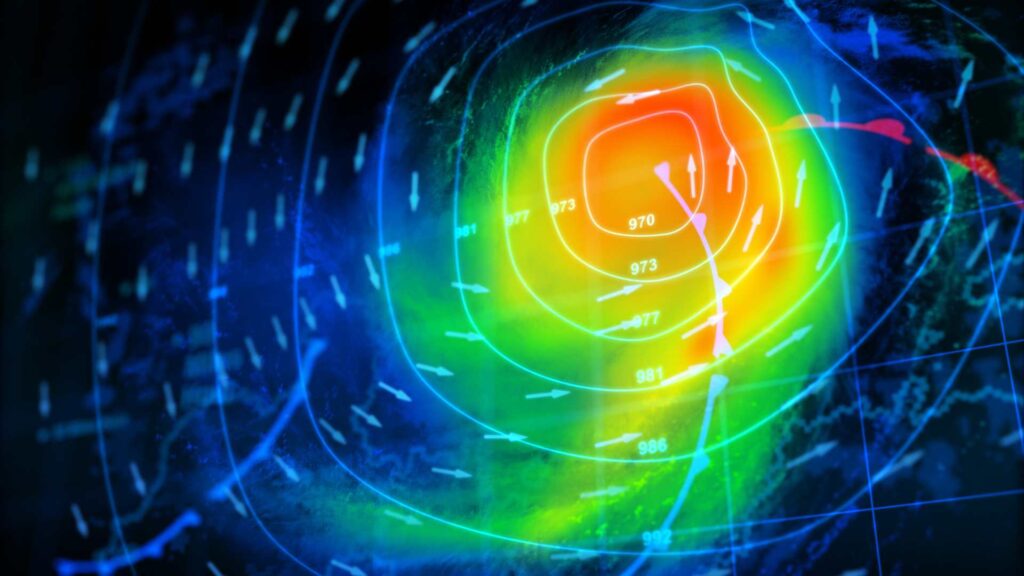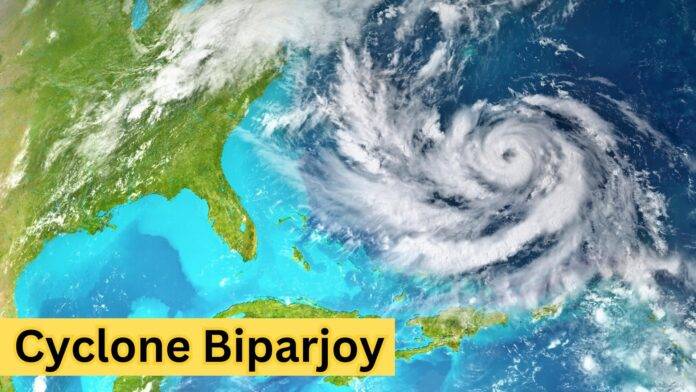Cyclone Biparjoy recently struck the coastal regions of Gujarat and Maharashtra, leaving behind a trail of destruction and impacting the lives of thousands of people. This article explores the formation and track of Cyclone Biparjoy, its impact on Gujarat and Maharashtra, the response of the government and local communities, and the lessons learned for future preparedness.
Reference by: https://www.bbc.com/
Formation and Track of Cyclone Biparjoy

Cyclone Biparjoy originated from a low-pressure system in the Arabian Sea. As it gained strength, it developed into a severe cyclonic storm. The Indian Meteorological Department closely monitored its formation and predicted its path, issuing timely warnings to the coastal states.
Preparations and Evacuations
Gujarat and Maharashtra authorities took emergency precautions before the cyclone’s landfall.
Evacuation plans were implemented to transfer people from dangerous places to safer shelters.
In collaboration with other relief organizations, the government worked tirelessly to secure the safety and well-being of the impacted people.
Cyclone Biparjoy Impact on Gujarat
Cyclone Biparjoy caused considerable damage to infrastructure in Gujarat, including roads, bridges, and electrical lines. Many coastal locations suffered severe rainfall and high gusts, disrupting daily life. The cyclone also resulted in crop losses, threatening farmers’ livelihoods.
Cyclone Biparjoy Impact on Maharashtra
Coastal areas of Maharashtra were severely affected by Cyclone Biparjoy. The region witnessed heavy rainfall, flooding, and triggering landslides in hilly areas. Fishing communities along the coast faced immense challenges as their boats and equipment suffered damage, impacting their livelihoods.
Safety Guidelines
To ensure the safety of individuals and communities during Cyclone Biparjoy, it is essential to follow these guidelines:
- Stay updated: Regularly check the IMD and local authorities’ official weather forecasts and advisories.
- Secure your property: Take measures to secure loose objects, reinforce doors and windows, and trim trees to prevent any potential damage.
- Stock up on essentials: Prepare an emergency kit with food, water, medicines, flashlights, and batteries.
- Stay indoors: Avoid venturing outside during the cyclone unless necessary. If outdoors, seek shelter in sturdy buildings away from trees and power lines.
- Stay away from the coast: Clear beaches, waterfront areas, and low-lying regions prone to flooding.
- Follow evacuation orders: If instructed to evacuate, promptly follow the authorities’ instructions and proceed to the designated shelters or safer locations.
Relief and Rescue Operations
Following the cyclone’s impact, relief and rescue operations were promptly initiated by the government and various humanitarian organizations. Rescue teams were deployed to assist those stranded in flood-affected areas, and essential supplies were provided to the affected population. The coordination between different agencies ensured a swift response to the crisis.
Government Response and Aid
The governments of Gujarat and Maharashtra played a crucial role in providing immediate aid to the affected communities. They allocated funds for relief and rehabilitation, focusing on reconstructing damaged infrastructure and providing necessary resources to those in need. The governments also collaborated with national and international organizations to expedite recovery.
Community Support and Rehabilitation
In addition to government efforts, local communities, and NGOs played an active role in supporting the affected population. Volunteer groups and social organizations provided food, water, and medical assistance to those affected by the cyclone. Rehabilitation programs were initiated to help affected communities rebuild their lives and regain economic stability.
Read More: Rivian Stock Price Prediction 2050
Read More: How to Get Started with International Mutual Fund Investments
Lessons Learned and Future Preparedness

Cyclone Biparjoy served as a wake-up call and provided valuable lessons that can guide future preparedness efforts. Here are some key takeaways:
- Early Warning Systems: The effectiveness of early warning systems in predicting cyclones and issuing timely alerts was evident during Cyclone Biparjoy. Investing in advanced forecasting technologies and strengthening communication networks can improve preparedness and enable early evacuation measures.
- Robust Infrastructure: The impact of Cyclone Biparjoy on infrastructure highlighted the need for more substantial, more resilient structures. Constructing strong buildings, roads, bridges, and power lines in vulnerable coastal areas can minimize damage and ensure the continuity of essential services during cyclonic events.
- Evacuation Plans: The successful execution of evacuation plans saved countless lives during Cyclone Biparjoy. Enhancing and regularly updating evacuation protocols, identifying safe shelters, and effectively communicating evacuation orders to the public is critical for ensuring a swift and organized evacuation process.
- Community Awareness: Educating coastal communities about cyclone preparedness and the necessary safety measures can significantly reduce the risks associated with such natural disasters. Regular awareness campaigns, training sessions, and mock drills can empower individuals to make informed decisions and take appropriate actions during cyclones.
- Collaborative Approach: The coordinated response of government agencies, relief organizations, and local communities played a crucial role in mitigating the impact of Cyclone Biparjoy. Continued collaboration and effective communication among these stakeholders is vital for a comprehensive and efficient disaster response.
- Sustainable Development: Encouraging sustainable development practices in coastal regions can help minimize the ecological impact of cyclones. Preserving natural barriers, such as mangroves and wetlands, can act as protective buffers against storm surges and reduce the vulnerability of coastal communities.
- Rehabilitation and Resilience: After the cyclone, prioritizing post-disaster rehabilitation efforts is essential. This includes providing adequate healthcare, clean water, sanitation facilities, and livelihood support to affected communities. Building resilience by diversifying income sources and promoting sustainable livelihoods can help communities recover and withstand future cyclonic events.
- Research and Development: Investing in research and development to improve cyclone prediction models, disaster management technologies, and innovative solutions can strengthen future preparedness. Collaborating with scientific institutions and leveraging technological advancements can enhance our ability to anticipate and mitigate the impact of cyclones.
By incorporating these lessons into future preparedness plans, we can minimize the loss of life, infrastructure, and livelihoods when faced with cyclonic events. Governments, communities, and individuals must work together, prioritize preparedness, and build resilience in the face of such natural disasters.
Cyclone Biparjoy wreaked havoc on the coastal regions of Gujarat and Maharashtra, causing extensive damage to infrastructure, disrupting lives, and affecting the livelihoods of many.
Frequently Asked Questions (FAQs)
Q: How was Cyclone Biparjoy formed?
A: Cyclone Biparjoy originated from a low-pressure system in the Arabian Sea. It gained strength and developed into a severe cyclonic storm.
Q: What were the impacts of Cyclone Biparjoy on Gujarat?
A: Cyclone Biparjoy caused significant damage to infrastructure, including roads, bridges, and power lines in Gujarat. Coastal areas experienced heavy rainfall, disrupting daily life. The cyclone also led to the loss of agricultural crops, affecting the livelihoods of farmers.
Q: How did Maharashtra get affected by Cyclone Biparjoy?
A: Coastal areas of Maharashtra witnessed heavy rainfall, resulting in flooding and triggering landslides in hilly regions.
Fishing communities along the coast faced challenges as their boats and equipment suffered damage, impacting their livelihoods.
Q: What were the relief and rescue operations carried out after Cyclone Biparjoy?
A: Prompt relief and rescue operations were initiated by the government and humanitarian organizations.
Rescue teams helped stranded individuals, and essential supplies were provided to the affected population, ensuring a swift response to the crisis.
Q: How did the government respond to the cyclone and provide aid?
A: The governments of Gujarat and Maharashtra allocated funds for relief and rehabilitation.
They focused on rebuilding damaged infrastructure and providing necessary resources to those in need.
Collaboration with national and international organizations expedited the recovery process.

